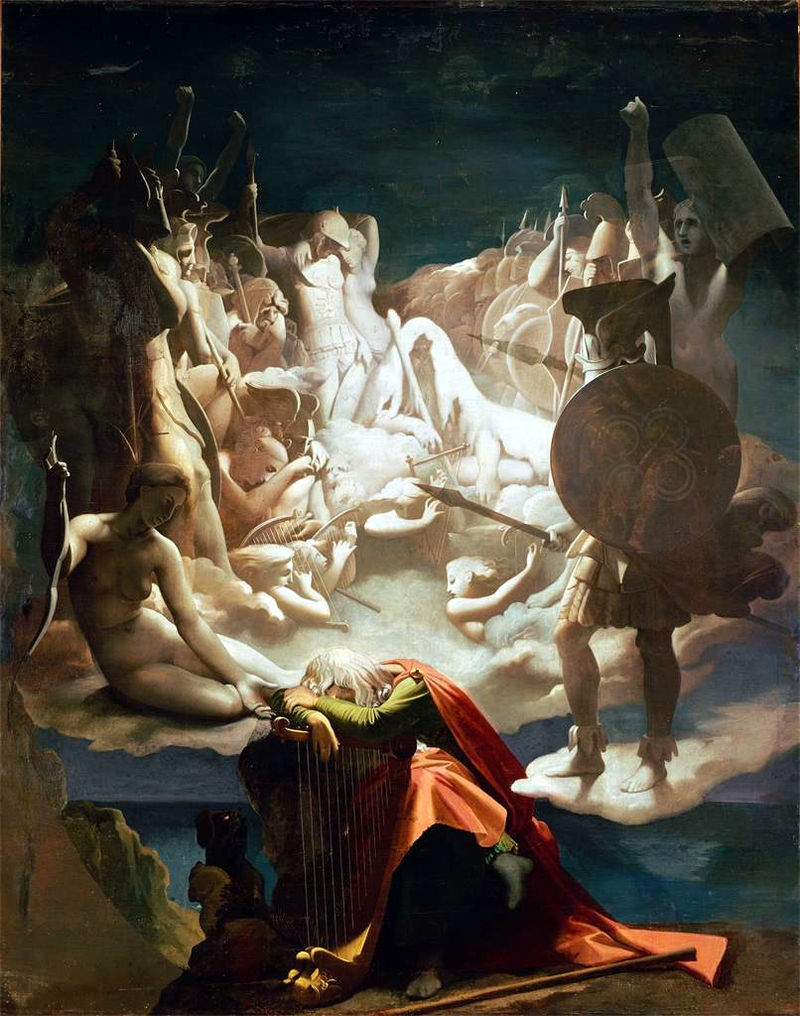YOU MAY have heard of Ossian. He was a Scottish warrior-poet. He told heroic tales about Finn MacCumhaill (MacCool) and his war band, the Fianna Éireann. But whoops, apparently his stories were stolen from Irish mythology and… whoops again… it is doubtful that Ossian even existed.
 Ossian’s Dream, Jean Auguste Dominique Ingres, 1813 By Jean Auguste Dominique Ingres
Ossian’s Dream, Jean Auguste Dominique Ingres, 1813 By Jean Auguste Dominique Ingres
In 1762, Scottish poet James Macpherson “discovered” the poems of Ossian from “old manuscripts” and “Highland legends.” He translated these poems into English, saying he had produced a great discovery for Scots Gaelic culture. He published his work and they were immediately wildly popular, and were translated all over Europe and Scandinavia. It inspired Romantic nationalism all across Europe.
Napoleon was a great admirer. Thomas Jefferson thought Ossian “the greatest Poet that has ever existed” and planned to learn Scots Gaelic so as to read his poems in the original. Ossian, the Scottish warrior poet was proclaimed as a Celtic equivalent of the Classical writers such as Homer. Many painters and composers of the time chose Ossianic subjects. King Charles of Sweden and Norway named his only son after a character from Ossian (Oscar); born in 1799, he later became King Oscar I of Sweden and Norway, and was succeeded by his son Oscar II.
But there was something fishy going on.
Many people say Ossian never existed and the works were largely the invention of Macpherson and were full of similarities to Homer, John Milton, and the Bible. Not only did Ossian never exist, apparently Macpherson stole a whole pile of originally Irish stories and rewrote them to make the heroes Scottish rather than Irish.
 Ossian and Malvina, by Johann Peter Krafft, 1810
Ossian and Malvina, by Johann Peter Krafft, 1810
Macpherson’s claim that the material was of Scottish origin was hotly opposed by Irish historians who felt that their heritage was being stolen. Macpherson also infuriated Irish scholars because Ossian’s Tales mixed Fenian and Ulster legends indiscriminately. Macpherson claimed that the Irish heroes were Caledonians and therefore a glory to Scotland’s past, rather than to Ireland’s.
Samuel Johnson, English author, critic, and biographer, was convinced that Macpherson was “a mountebank, a liar, and a fraud, and that the poems were forgeries.” Johnson also dismissed the poems’ quality. Upon being asked, “But Doctor Johnson, do you really believe that any man today could write such poetry?” he famously replied, “Yes. Many men. Many women. And many children.” Johnson is cited as calling the story of Ossian “as gross an imposition as ever the world was troubled with.”
Macpherson carried on saying he translated the tales from mysterious manuscripts… but there still remained a painfully obvious fact…The Highland legends MacPherson compiled as “The Works of Ossian, The Son of Fingal“ took place at least 500 years after the days of Fionn mac Cumhall and 800 years after Cú chulainn.
Macpherson did well out of his little adventure mixing fiction, legend and his own poetry. He is buried among the literary giants in Westminster Abbey. But it seems that this controversy did not die out with Macpherson. Modern-day scientists have been investigating this whole literary controversy and have got some seriously interesting results that they want to share with us.
In a joint study by Coventry University, the National University of Ireland, Galway and the University of Oxford, published today in the journal Advances in Complex Systems, researchers have revealed the structures of the social networks of the characters in Ossian’s tales have stark similarities to Irish mythology.
The researchers mapped the characters at the heart of the works and the relationships between them to compare the social networks found in the Scottish epics with classical Greek literature and Irish mythology.
The study revealed that the networks in the Scottish poems bore no resemblance to epics by Homer, but strongly resembled those in mythological stories from Ireland.
So Ossian’s poems that launched the romantic portrayal of the Scottish Highlands? It is probably a lie.
 In the social network underlying the Ossianic epic, the 325 nodes represent characters appearing in the narratives and the 748 links represent interactions between them. Credit: Coventry University
In the social network underlying the Ossianic epic, the 325 nodes represent characters appearing in the narratives and the 748 links represent interactions between them. Credit: Coventry University
Professor Ralph Kenna, a statistical physicist based at Coventry University, said, “By working together, it shows how science can open up new avenues of research in the humanities. The opposite also applies, as social structures discovered in Ossian inspire new questions in mathematics.”
Dr Justin Tonra, a digital humanities expert from the National University of Ireland, Galway said, “From a humanities point of view, while it cannot fully resolve the debate about Ossian, this scientific analysis does reveal an insightful statistical picture: close similarity to the Irish texts which Macpherson explicitly rejected, and distance from the Greek sources which he sought to emulate.”
So there you go. Science pretty much says James Macpherson robbed Irish myths and made them into Scottish tales penned by a non-existent person called Ossian. Okay now that we have that sorted out, we can all go for ales and get on with our lives.
Article first published on www.oldmooresalmanac.com

